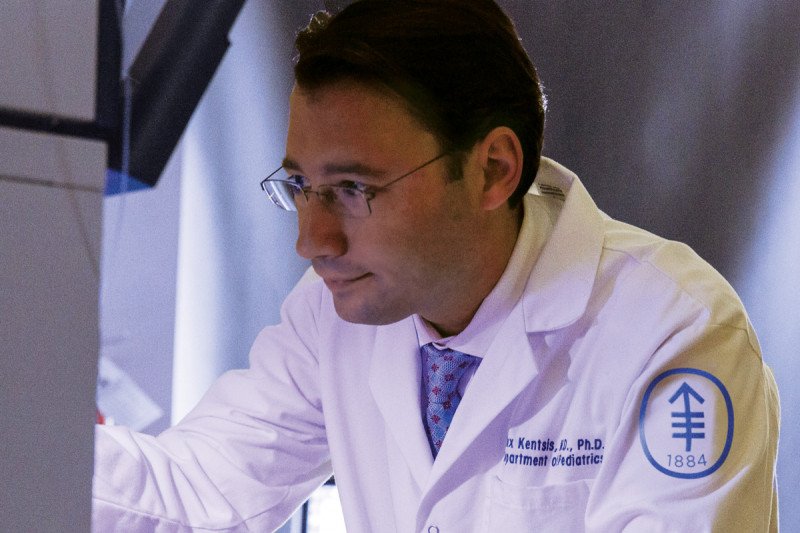
A team led by Alex Kentsis found that a class of drugs can selectively kill PGBD5-expressing tumor cells by inhibiting enzymes that alert the cells to DNA damage.
Sometimes, the same biological means by which normal cells turn cancerous can also be a chink in their armor. Memorial Sloan Kettering researchers want to take advantage of a weakness created in cancer cells as they become malignant and multiply out of control. This approach shows promise as a way to treat many pediatric cancers.
In May 2017, a research team led by MSK cancer biologist and pediatric oncologist Alex Kentsis made a surprising discovery. A majority of solid tumors in children appear to be caused by a single — and very unusual — genetic change. When a gene called PGBD5 becomes abnormally activated, the protein it produces snips DNA segments and flips them to a different location within the genome. This DNA change can wreak havoc on other genes and trigger certain pediatric and adult cancers.
When the PGBD5 protein scrambles other genes, it creates breaks in the DNA that must continuously be fixed in order for the cell to survive. This damage causes cells with a lot of PGBD5 to be especially dependent on enzymes involved in DNA repair.
Now Dr. Kentsis’s team reports in Science Translational Medicine that a class of drugs can selectively kill PGBD5-expressing tumor cells by inhibiting enzymes that alert the cells to DNA damage. When these enzymes fail to transmit signals needed to start the repair process, the tumor cells become so overwhelmed by DNA damage that they self-destruct.
The study was led by Dr. Kentsis and Anton Henssen, a postdoctoral research fellow in Dr. Kentsis’s laboratory who recently established his own lab at the Berlin Charité Hospital. In experiments with genetically modified mice and human cells in a lab dish, the drug AZD6738 destroyed the tumor cells from aggressive neuroblastomas (cancers of the nervous system) and medulloblastomas (brain tumors). Normal cells were unharmed.
“We’ve found that PGBD5 remains active in these cancers, as well as in Ewing sarcomas and rhabdoid tumors, which also occur mainly in children,” Dr. Kentsis says. “Blocking specific DNA damage signals could be an effective way to treat these childhood solid tumors.”
Exploiting a Weakness
The treatment strategy demonstrated by Dr. Kentsis’s team is called synthetic lethality. It involves disabling a critical function in cells that have an existing genetic impairment. The combination leaves the cells defenseless. This concept has been around for decades, but it has recently emerged as a promising way to treat cancer. For example, a class of drugs called PARP inhibitors appears to be especially effective in women with breast cancer or ovarian cancer who have mutations in BRCA genes, which also regulate DNA repair.
The team led by Drs. Henssen and Kentsis screened a number of currently available drugs that target enzymes involved in DNA-damage signaling. They identified AZD6738 as a good candidate for treating PGBD5-expressing tumors. AZD6738 is already in phase II clinical trials in combination with chemotherapy and other drugs for several advanced forms of cancer, including colorectal, ovarian, and small cell lung cancers.
In addition, many similar drugs that interfere with DNA repair are also in clinical trials. Dr. Kentsis suggests it’s likely that specific drugs from this entire class will prove useful against many cancers that express PGBD5.
Dr. Kentsis and his colleagues have proposed testing AZD6738 in a basket trial for people who have solid tumors with PGBD5 expression. (Traditional clinical trials focus on cancer types, and basket trials treat people with a specific mutation found in the tumor, regardless of where the cancer originated.) For PGBD5, this would include the majority of childhood solid tumors, as well as certain colon, breast, and small cell lung cancers.
“This has immediate implications for patients with a wide range of cancers with PGBD5 expression,” Dr. Kentsis says. “We hope we can begin testing this new treatment within a year.”






